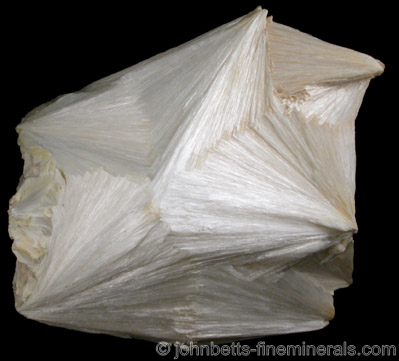The Mineral pectolite

Pectolite is a unique mineral known for its interesting crystal habits. Its crystals primarily form as extremely slender and elongated densely grouped fragile fibers radiating from a central point outwards. When the fibers are very densely-packed, the result formation is as thick, globular masses. Pectolite can be tough and dense, but is often very delicate and soft to the touch. It can be dented by just touching it too hard, and thin splinters are easily broken when handled. Pectolite specimens are also known to give splinters when handling due to their slender and brittle crystals which easily break.
Chemical Formula
NaCa2Si3O8(OH)
Color
White, colorless, gray, light yellow, brown, pink, orange, salmon, and light blue. Some specimens tarnish brown or black upon exposure to air.
Varieties
-
Light blue to blue variety of Pectolite that is found in the Dominican Republic. Also see the gemstone section on Larimar.
Uses
Pectolite is used mainly a collectors mineral. Good specimens especially from the New Jersey traprocks are increasingly hard to obtain and are sought out by mineral collectors. The light blue variety Larimar is used as a minor gemstone and is a rarity for collectors. When not cut as a gemstone, Larimar specimens are sliced and polished to highlight the colors.
More information on Larimar can be found in the gemstone section.
Noteworthy Localities
European localities include Těchlovice and Kostalov in Bohemia, Czech Republic; and Kreimbach-Kaulbach, Germany. The famous blue Larimar variety is only found in Caribbean country of the Dominican Republic, at the Filipinas Mine in Los Checheses.
The finest specimens for this mineral were found in the traprock quarries of northeastern New Jersey. Some of the best and thickest groupings came from Paterson and Prospect Park, Passaic Co. Millington, Morris Co., was known for outstanding white, pink, salmon, and yellow globular Pectolite masses that often formed in cavities and geodes. Thick radiating Pectolite veins lining seams in diabase were found in the Palisades sill at Bergen Hill, Hudson Co.; in Ft. Lee, Bergen Co.; and across the state border at Rockland Lake, Rockland Co., New York.
Other U.S. occurrences of this mineral are Magnet Cove, Garland Co., Arkansas, and Island Royale in Lake Superior, Michigan, where pink, waterworn pebbles can be found on the beach.
In Quebec, Canada, two famous localities have produced individual crystals of Pectolite that are drastically different than all others. The Jeffery Quarry, Asbestos; and Mont Saint Hilaire have produced prismatic and elongated crystals and groupings of such crystals.
Distingushing Similar Minerals
Wollastonite - Occurs in different environments.
Tremolite - Slightly harder (5 - 6), usually flexible, not usually in radiating form.
Natrolite and Mesolite - Crystals are usually larger and aggregated less densely; otherwise difficult to distinguish.